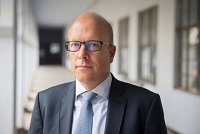Sustainable production is not enough
13.11.2020
Politicians and industry are talking about CO2- even climate-neutral production. But this does not go far enough, said Prof. Christoph Herrmann, head of the Institute of Machine Tools and Production
 Global challenges require interdisciplinary approaches. (Source: Christopher Rusev (Unsplash)
Global challenges require interdisciplinary approaches. (Source: Christopher Rusev (Unsplash)
Technology at the TU Braunschweig, at the 10th annual congress of the WGP (Academic Association for Production Technology). “Production cannot be separated from the life cycle of the product if we do not want to simply shift environmental problems from one life cycle phase to another.” Therefore, a scientifically based, objective framework is necessary to be able to carry out quantitative environmental assessments for new products and production technologies and to make alternatives comparable. “For electric vehicles, for example, we can calculate the influence of the production location for battery cells on the ecological advantage over conventional cars.”
 Herrmann has been researching for years on models and methods for estimating the environmental impact of products and production processes. All life phases of a product are analysed, from the extraction of raw materials to the end of its life. “If we plan climate neutrality only for the step of production, it can happen that we merely shift the problem, for example from the use phase to the recycling phase or from effects on climate change to ecotoxicity. To avoid this, we have to integrate quantitative environmental assessment, the so-called life cycle assessment, into the product development process,” warns Herrmann. “So far, however, a broad application is not yet possible, as this balance is insufficiently embedded in an engineering procedure. In addition, the visualisation has not been tailored yet to the target groups, which hinders an interpretation of the results. The hotspots with the greatest impact on the environment and especially possible starting points for product and process innovations are therefore difficult to identify. Only if we change this, we will be able to create the path to life cycle engineering which is oriented towards ecological sustainability.”
Herrmann has been researching for years on models and methods for estimating the environmental impact of products and production processes. All life phases of a product are analysed, from the extraction of raw materials to the end of its life. “If we plan climate neutrality only for the step of production, it can happen that we merely shift the problem, for example from the use phase to the recycling phase or from effects on climate change to ecotoxicity. To avoid this, we have to integrate quantitative environmental assessment, the so-called life cycle assessment, into the product development process,” warns Herrmann. “So far, however, a broad application is not yet possible, as this balance is insufficiently embedded in an engineering procedure. In addition, the visualisation has not been tailored yet to the target groups, which hinders an interpretation of the results. The hotspots with the greatest impact on the environment and especially possible starting points for product and process innovations are therefore difficult to identify. Only if we change this, we will be able to create the path to life cycle engineering which is oriented towards ecological sustainability.”
Herrmann adds that building up expertise in life cycle assessment and life cycle engineering will “further increase internal complexity, especially since we have to think not only about the ecological, but also the economic and social dimensions of innovative solutions”. However, in view of the political goals in Germany and the European Green Deal, which have set themselves the goal of almost climate neutrality by the middle of the century, manufacturing companies cannot avoid rethinking.
More computer-aided tools
Life cycle assessments depend on a large number of factors, such as the materials used, whose ecological impact can be very variable. But also the share of renewable energy sources, the price of electricity and last but not least the climate at the production site play a role. The influence on the climate, the so-called greenhouse potential, naturally increases with higher CO2 intensity of the local electricity mix. The share of renewables is particularly high in Sweden, for example, while in France, nuclear power initially offers advantages for the CO2 footprint.
The extremely complex balance sheets in which such a large number of product and production parameters must be considered and visualised can only be made transparent by computer-aided models, Herrmann emphasises. One approach is the so-called ‘Integrated Computational Life Cycle Engineering’. It couples models of production on the one hand with models describing the utilisation phase or operation and on the other hand with models for end-of-life, i.e. recycling, recovery and use. This approach allows statements on the life cycle performance of new product and production technologies with regard to both technical-economic parameters (e.g. life cycle costs) and ecological parameters (e.g. environmental evaluation). “However, today’s computers and corresponding software tools are already so powerful that integrative modeling and simulations of even complex overall models are possible,” the Braunschweig-based production engineer is certain. “Even different background systems, which take into account technological, inter-individual, geographical and temporal variability, can be modeled and make application-oriented research possible.”
Life cycle assessment of e-cars strongly dependent on battery
Taking e-mobility as an example, the benefits of life cycle assessments can be demonstrated, which include the complete life cycle of an electrically powered car in the calculation - from cradle to grave, as they say. “In the case of a VW ID, more than 43 % of the CO2 equivalent in relation to vehicle manufacture is attributable to battery production,” Herrmann calculates. “Sustainable battery production is therefore of great importance for the ecobalance of e-mobility.” Many research institutes are already working on this. The recently launched accompanying project “2nd Use & Green Battery” from the “Battery Research Factory” of the Federal Ministry of Education and Research (BMBF), for example, is dedicated to the holistic evaluation of raw material cycles and 2nd use concepts of batteries, among other things. Herrmann is one of the speakers of the associated cluster.
Interdisciplinarity as inspiration
 Climate change, but also pandemics or digitisation: We are facing global challenges that raise highly complex questions. Excellent innovative research is needed to find answers to these questions, according to the credo of Prof. Matthias Kleiner, President of the Leibniz Association. In his keynote speech, the scientist and professor for forming technology warned against dealing only with one's own discipline. “Individual researchers and disciplines quickly reach their limits. We need joint action and mutual inspiration right now. Only this makes radical discoveries possible, which we urgently need.” Using plasma technology as an example, he explained what the diversity of perspectives in inter- and transdisciplinary research groups makes possible. Plasma technology has long played an important role in production engineering, for example in additive manufacturing or surface processing. However, plasma can also accelerate wound healing and is playing an increasingly important role in the healthcare sector.
Climate change, but also pandemics or digitisation: We are facing global challenges that raise highly complex questions. Excellent innovative research is needed to find answers to these questions, according to the credo of Prof. Matthias Kleiner, President of the Leibniz Association. In his keynote speech, the scientist and professor for forming technology warned against dealing only with one's own discipline. “Individual researchers and disciplines quickly reach their limits. We need joint action and mutual inspiration right now. Only this makes radical discoveries possible, which we urgently need.” Using plasma technology as an example, he explained what the diversity of perspectives in inter- and transdisciplinary research groups makes possible. Plasma technology has long played an important role in production engineering, for example in additive manufacturing or surface processing. However, plasma can also accelerate wound healing and is playing an increasingly important role in the healthcare sector.
“In interdisciplinary groups, old certainties tend to be questioned in order to find new solutions under changed conditions. This is not only the prerequisite for meeting the complex challenges of our globalised world, but it is also the central strategy for keeping Germany fit for the future,” says Kleiner.
Editor: Steffen Donath
Source: www.etmm-online.com





































